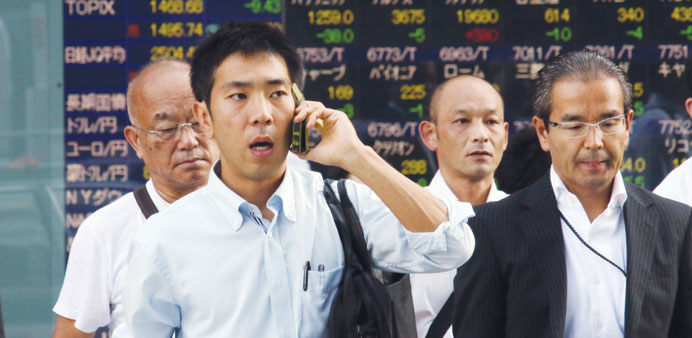Businessmen pass before a share prices board in Tokyo. Japanese stocks closed down 70.29 points to 18,095.40 points yesterday.
AFP/Tokyo
Asian stocks were hit by a fresh round of volatility yesterday, as further evidence of slowing growth in China’s economy cast a cloud over global markets.
Following hefty early losses, some regional bourses reversed direction to close in positive territory—the latest session of roller-coaster trade as concerns over the worldwide outlook keep investors on edge.
In early European business London, Paris and Frankfurt ticked up after suffering a painful sell-off, along with Wall Street, on Tuesday.
The Australian dollar—heavily linked to demand for the country’s abundant natural resources—plumbed six-year lows as figures showed the economy logged a slower-than-expected 0.2% quarterly expansion.
That came after Canada officially entered recession, hit hard by stubbornly low oil prices.
Both countries’ economies are dependent on the exports of commodities—such as iron ore—that have powered Chinese growth over the past decade.
Adding to tensions are uncertainties about whether the US Federal Reserve will raise interest rates at a policy meeting this month.
“You have worries about the global growth outlook, led by Chinese concerns at a time when the Fed is thinking about raising interest rates, and that’s leaving investors very twitchy,” Shane Oliver, a global strategist at AMP Capital Investors in Sydney, told Bloomberg News.
“I think we’ve seen the worst, but it’s an environment where volatility is likely to continue.”
Tokyo saw some of the worst turbulence, opening sharply lower only to rally at mid-session and then close down 0.39%.
Shanghai plunged 4.39% at the beginning of the day, jumped into positivity by lunch but ended 0.20% lower. Analysts said the heavy losses were largely erased thanks to government support ahead of a two-day World War II remembrance holiday.
On Tuesday official data showed Chinese factory activity contracted in August, the latest sign that growth in China—which accounts for more than 13% of global GDP—is slowing.
While the Shanghai market is somewhat decoupled from the real economy—many analysts and players acknowledge it is akin to gambling—wild swings there are seen as worrying signs of Beijing’s inability to manage structural change.
Commentators say China’s high government-spending model of the past three decades is unsustainable, and must transition into consumer spending. Washington, whose own recovery from the global financial crisis is still far from entrenched, will this week urge China to better communicate its policies, when representatives from the Group of 20 meet in Turkey.
Treasury Secretary Jacob Lew “will emphasise that, fundamentally, the world needs more demand”, said a US official, who spoke on condition of anonymity.
Wu Kan, a Shanghai-based fund manager at JK Life Insurance Co, said Beijing appeared to have been buying blue-chip stocks in recent days in an effort to support the market.
“But investors have lost confidence amid the ongoing de-leveraging and the overnight global rout,” he said. “The correction isn’t over yet.”
The state-owned China Securities Journal reported yesterday securities firms were transferring more funds to a government-supported fund to help stabilise the market.
Analysts estimate the government has spent hundreds ofbns of dollars to prop up stock prices.
The jitters in China were reflected across most of the region. Hong Kong swung in and out positive territory through the day and was down 0.90% in late trade. Seoul ended 0.05% higher after starting in the red.
In Sydney, where several companies with close ties to China are listed, the main index spent most of the session in the red before a late rally pushed it just 0.1% higher.
Europe’s three main markets were all higher at the start, with London adding 0.74%, Paris up 0.84% and Frankfurt 0.77% higher.



